No, Trump Nuke Strategy Doesn’t Doom Planet: DUSD Policy
Posted on
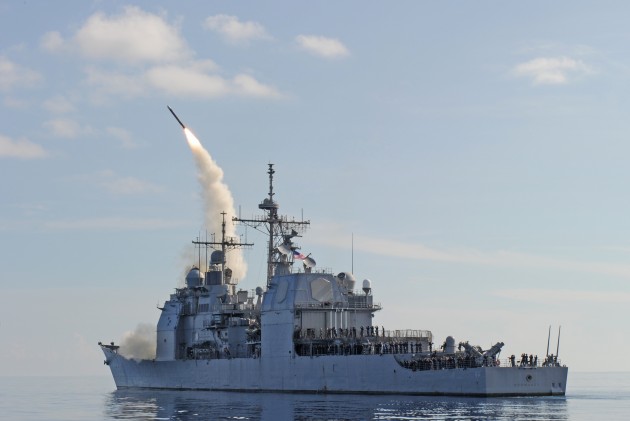
Tomahawk launch from the USS Normandy. The Trump administration may revive the nuclear variant.
HERITAGE FOUNDATION: Just calm down and read the document. That, in essence, is the administration’s response to critics who call its new nuclear strategy irresponsible and dangerous. In fact, deputy undersecretary for policy David Trachtenberg said over and over here this morning, the Nuclear Posture Review is fundamentally conservative (with a small “c”). The 2018 NPR, he said,
- is based on mainstream consensus about deterrence;
- adapts deterrence to new threats, especially Russia;
- was developed in concert with our allies;
- adds only modest “supplements” to Obama’s buildup plans, namely two new low-yield nuclear weapons;
- and will require sustained bipartisan support to implement.
A less Trumpian argument is hard to imagine, given the president’s contempt for consensus, his reluctance to confront Russia, and his enthusiasm for a nuclear build-up. “Let there be an arms race,” he said as president-elect. But Trachtenberg’s measured rhetoric matches that of Defense Secretary Jim Mattis, who has emphasized the Chinese and Russian threat, reached out both hands to allies, and largely kept the Pentagon out of partisan politics.
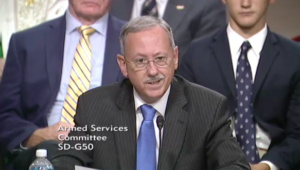
David Trachtenberg testifies to the Senate at his confirmation hearing.
This is the context of the NPR, which largely “reaffirms longstanding mainstream principles of US nuclear policy,” Trachtenberg told the audience at the conservative Heritage Foundation. “Unfortunately, you might be hard pressed to know that if you read some of the commentary on the NPR,” he added, before reading a selection of headlines from “flawed overkill” to “new arms race,” “threatening doomsday,” “playing with fire,” and “US likely to use nuclear weapons.”
In fact, Trachtenberg implied but didn’t say aloud, if there ever was a Nuclear Posture Review that departed from settled principles, it was the Obama Administration’s in 2010. The Obama NPR assumed steadily improving relationships with Russia and China in which unilateral US arms reductions would encourage others to follow suit.
“It is now clear that our attempts to lead by example… have not been reciprocated,” he said dryly. This conclusion “is shared by our allies, with whom we consulted extensively, and by senior figures in the previous administration.”
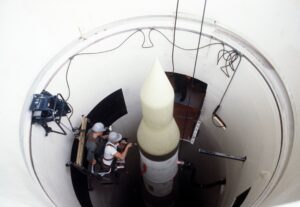
Minuteman ICBM silo
Even so, Trachtenberg said, the Obama and Trump strategies agree in many ways. Both call for retaining and modernizing the aging nuclear triad of bombers, submarines, and ICBMs, as well as the overarching command and control system, an effort which would more than double nuclear weapons spending at its peak. Both refuse to pledge “no first use” of nuclear weapons and reserve America’s right to use nukes to deter and respond to (vaguely defined) “strategic non-nuclear” attacks.” Both emphasize US compliance with arms control treaties, with Trachtenberg explicitly saying the US will honor the Intermediate Nuclear Forces (INF) pact that Russia has violated.
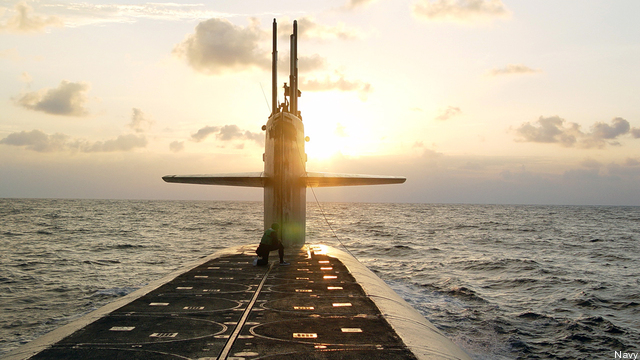
An Ohio-class nuclear missile submarine (SSBN).
So what’s new? Besides reaffirming and clarifying longstanding policy, Trachtenberg argues, the big difference is really pretty small: two new low-yield weapons that the NPR calls mere “supplements” to Obama’s plan to modernize the triad. One would be a lower-yield version of current submarine-launched ballistic missiles (SLBMs), the other a revival of the nuclear Sea-Launched Cruise Missile (SLCM) retired under Obama. Since the SLBM is just a modification of an existing warhead and the SLCM just the revival of an old weapon, he said, neither would require new nuclear tests or violate existing arms control agreements.
New Weapons, New Doctrine
Why do we need less powerful weapons? The Russian doctrine of “escalate to deescalate” argues they could end a war on their own terms with a limited nuclear strike to which the US would lack the will or weapons to respond. So, the NPR concludes, the US needs to develop suitably low-yield nukes that can retaliate to such a limited strike in kind, without the US having to escalate to using strategic nuclear weapons.
It’s these proposed low-yield weapons that most outrage critics of the NPR, who say their limited power would make the nuclear option less unthinkable and therefore more likely to be used. Trachtenberg noted wryly that many of these same critics had earlier denounced the US arsenal as “overkill” for its excess of high-yield weapons — some of which the NPR would modify to be less destructive.
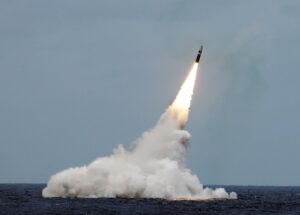
Navy test of a Trident Submarine-Launched Ballistic Missile (SLBM)
Specifically, the easiest, quickest, and cheapest way to get new low-yield nukes is just to modify existing Trident Submarine-Launched Ballistic Missiles (SLBMs). The US already has low-yield nukes, Trachtenberg emphasized, but those are launched by aircraft. Submarines can hide from enemy preemptive strikes better than aircraft, let alone air bases, and an SLBM moving at roughly 15,000 mph might penetrate enemy air and missile defenses where a plane could not. So the low-yield SLBM doesn’t lower any thresholds on yield. It just creates another option that multiplies the enemy’s problems and makes it harder for Moscow to imagine they can neutralize US nukes.
In the longer term, the NPR calls for a new Sea-Launched Cruise Missile (SLCM) to be fired from surface ships and submarines. Cruise missiles are slower than ballistic missiles because they fly through the atmosphere like aircraft. Essentially they’re one-way drones, but that also makes them more flexible. The US doesn’t have a nuclear SLCM today, Trachtenberg said, but that’s only because Obama’s 2010 NPR decided to retire the nuclear-tipped version of the Tomahawk. (Tomahawks with conventional warheads remain in widespread service).
Would the SLCM program just revive the nuclear Tomahawk — the quickest option — one reporter asked. Would it be a naval version of the Air Force’s forthcoming Long-Range Stand-Off (LRSO) cruise missile? Or would it be something entirely new and presumably much more expensive to develop? All Trachtenberg would say was that the Pentagon will launch a formal Analysis of Alternatives (AOA) to study just such questions. And few AOAs take less than 18 months to complete.
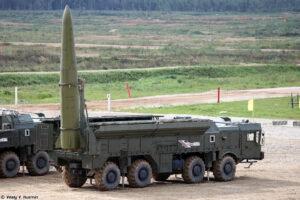
Russian Iskander (SS-20) ballistic missile launcher, accused by the US of violating the Intermediate Nuclear Forces (INF) Treaty
Trachtenberg was even vaguer about the NPR’s proposal to better “plan, train, and exercise to integrate U.S nuclear and non-nuclear forces.” Critics denounced he implication that the US might use nuclear strikes alongside ongoing conventional operations, without a strict firebreak in between — as in current Russian doctrine — although the NPR never explicitly says that’s what “integration” means.
“Our exercises, I don’t think, come anywhere close” to what the Russians are doing, Trachtenberg told me after his public talk. But, I pressed, will our training and doctrine look more like the Russians’ once we’ve implemented the NPR recommendations to “integrate” nuclear and non-nuclear forces? “I really don’t see us making significant movements along the lines that you’re suggesting, but a lot of that is hypothetical,” Trachtenberg says. “We’ll see how implementation goes.”
Implementing the NPR will not only involve Trachtenberg’s staff in the Pentagon’s policy shop, he emphasized, but also hands-on war planners and warfighters from the Joint Staff and across the Defense Department. It will also require sustained bipartisan support in Congress for “decades” to fund both the Obama modernization plan and the Trump NPR’s “relatively modest” additions.
“It took a year to develop the NPR…but that was probably the easy part,” Trachtenberg told the Heritage audience. “The tough part is the implementation and that will require us making the case,” as he was doing today. “The real challenge is how do we maintain the necessary support in a bipartisan way to do what needs to be done.”
Subscribe to our newsletter
Promotions, new products and sales. Directly to your inbox.
